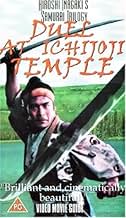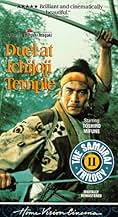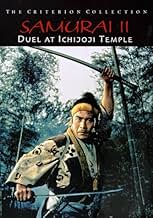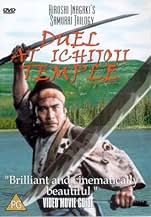IMDb-BEWERTUNG
7,3/10
7297
IHRE BEWERTUNG
Füge eine Handlung in deiner Sprache hinzuMusashi Miyamoto returns to Kyoto after years of absence. After a series of fights against the Yoshioka School, he challenges its master to a duel.Musashi Miyamoto returns to Kyoto after years of absence. After a series of fights against the Yoshioka School, he challenges its master to a duel.Musashi Miyamoto returns to Kyoto after years of absence. After a series of fights against the Yoshioka School, he challenges its master to a duel.
Empfohlene Bewertungen
The great cast that was in Musashi Miyamoto, the first part of this samurai trilogy continues in the second part with a few additions.
By this time Musashi Miyamoto has been on the road for three years and is still learning. The most important lesson as a Samurai will not be learned until the film is almost over. Another important lesson comes quickly after that, and it will interesting to see how it plays out in the final part.
In the opening Musashi Miyamoto is doing battle with a samurai similar to our buddy Hanzo. They are the only two I have ever seen use chains.
After this he heads to Kyoto to do battle with the best in the capital, and also to get himself mixed up with the two women who are in love with him.
Love, fickleness, treachery, rape, revenge, honor, and great sword fighting all have a place in this magnificent film.
The amazing cinematography and scenery also place an important part.
This is truly a samurai classic.
By this time Musashi Miyamoto has been on the road for three years and is still learning. The most important lesson as a Samurai will not be learned until the film is almost over. Another important lesson comes quickly after that, and it will interesting to see how it plays out in the final part.
In the opening Musashi Miyamoto is doing battle with a samurai similar to our buddy Hanzo. They are the only two I have ever seen use chains.
After this he heads to Kyoto to do battle with the best in the capital, and also to get himself mixed up with the two women who are in love with him.
Love, fickleness, treachery, rape, revenge, honor, and great sword fighting all have a place in this magnificent film.
The amazing cinematography and scenery also place an important part.
This is truly a samurai classic.
Being the middle film of a trilogy, Duel at Ichijoji Temple thankfully came with a lot more battle sequences than the first film, and had more finesse in its swordplay since our legendary heroic character Takezo (Toshiro Mifune) is now a skilled swordsman, but yet to put into practice many aspects of Bushido, and often criticized in the manner in which he finishes off his opponents because of his innate brute strength and force.
But I guess when you're top dog, criticism comes part and parcel, and in his warrior pilgrimage in discovery of skill and self, we see how he further develops, though at time I felt that the story utilized a cheat sheet just like the first film, where priest Takuan (Kuroemon Onoe) locked him in a castle with plenty of books. Here, while Takezo is in hiding, he spends plenty of time indoors under the patronage of Lady Yoshino (Michiyo Kogure), a courtesan who would inculcate some compassion into the gruff man's life - while he looks refined on the outside, his ambition and reputation continue to earn him no favours, especially since he had issued a challenge to the Yoshioka School.
As a middle film, it expanded the mythology, and further developed the characters who made teasing appearances in the first one. For instance, the young man who was smitten by Akemi (Mariko Okada) turns out to be none other than the leader of the Yoshioka School, Seijuro Yoshioka (Akihiro Hirata), who in a fit of envy began to violate Akemi, taking his ineptness onto a helpless girl. Such are incidents that make the character a little revolting, and the members of his school showcased to be nothing more than mere bullies to the townsfolk, as well as constantly sucking up to Seijuro by shielding his incompetence from the real world.
The villains in this installment turn out to be more formidable than the thugs and brigands that Takezo had to deal with earlier. In fact, the first duel was a battle with an opponent using a chain-and-sickle, in compensation for the lack of a swordfight as a climax in the first film. Unfortunately I found this to be mildly exciting, as the full screen presentation only allowed for that fatal blow to be delivered off screen. The middle duel with Denshichiro Yoshioka was also somewhat of a let down given the buildup, because it only allowed a brief clashing of the weapons, before director Hiroshi Inagaki decided to cut away to a song! It felt like a little short-change, though the result of the match was made known indirectly later.
And the expansion of the characters here only made the story richer. Familiar faces like Takezo's lover Otsu (Kaoru Tachigusa) returns to pine a lot more for him after 3 years of waiting, while her ex-fiancé Matahachi (Sachio Sakai) degenerates worse in character, into a good for nothing liar and a cheat, married to Akemi's scheming mom Oko (Mitsuko Mito). We also get introduced to sword polisher Hanomi (Ko Mihashi) who's supposed to play an influential role in swaying Takezo's mindset, though the narrative here didn't allow too much of that on screen, deflecting it towards Lady Yoshino, for yet another romantic entanglement, where the female characters are all weak in their knees in Takezo's manly presence.
But the most important character introduced in the film would be Kojiro Sasaki (Koji Tsuruta), the eventual nemesis of Takezo's, but you've got to wait until the next film to see them do battle. Here, Kojiro's like the predator, slowly studying and stalking his prey. We know little of his background, apart from his certification of swordsmanship, and his cool, collected demeanour as opposed to Takezo's brash emotions, so that already sets him up to be mile apart as a strong adversary in time to come. So far he has played things in quite a gentlemanly way, refusing to take cheap shortcuts, patiently and probably egoistically waiting for Takezo to attain more skills, before bringing down a powerful opponent.
Again the technical aspects of this DVD presentation left much to be desired, especially in the night or dawn battle scenes. It's not digitally remastered, so these scenes become really dark and marred the enjoyment of many outdoor fights, especially the titular one where Takezo goes up against 80 opponents, and learns for a start that evading battle may not be so bad an option, especially when one is severely outnumbered due to a sickening, dishonourable scheme to turn tables. I would have wished for a better presentation so that it would not detract your attention to pops and cackles, or unintentional hues to come and stain the picture quality.
Duel at Ichijoji Temple ended just like how it began, with Takezo continuing his journey to seek bushido-enlightenment. It wrapped up some of the life journeys and lessons learnt by the protagonist in this episode, and sets it all up for the climax to be in the last installment of the trilogy.
But I guess when you're top dog, criticism comes part and parcel, and in his warrior pilgrimage in discovery of skill and self, we see how he further develops, though at time I felt that the story utilized a cheat sheet just like the first film, where priest Takuan (Kuroemon Onoe) locked him in a castle with plenty of books. Here, while Takezo is in hiding, he spends plenty of time indoors under the patronage of Lady Yoshino (Michiyo Kogure), a courtesan who would inculcate some compassion into the gruff man's life - while he looks refined on the outside, his ambition and reputation continue to earn him no favours, especially since he had issued a challenge to the Yoshioka School.
As a middle film, it expanded the mythology, and further developed the characters who made teasing appearances in the first one. For instance, the young man who was smitten by Akemi (Mariko Okada) turns out to be none other than the leader of the Yoshioka School, Seijuro Yoshioka (Akihiro Hirata), who in a fit of envy began to violate Akemi, taking his ineptness onto a helpless girl. Such are incidents that make the character a little revolting, and the members of his school showcased to be nothing more than mere bullies to the townsfolk, as well as constantly sucking up to Seijuro by shielding his incompetence from the real world.
The villains in this installment turn out to be more formidable than the thugs and brigands that Takezo had to deal with earlier. In fact, the first duel was a battle with an opponent using a chain-and-sickle, in compensation for the lack of a swordfight as a climax in the first film. Unfortunately I found this to be mildly exciting, as the full screen presentation only allowed for that fatal blow to be delivered off screen. The middle duel with Denshichiro Yoshioka was also somewhat of a let down given the buildup, because it only allowed a brief clashing of the weapons, before director Hiroshi Inagaki decided to cut away to a song! It felt like a little short-change, though the result of the match was made known indirectly later.
And the expansion of the characters here only made the story richer. Familiar faces like Takezo's lover Otsu (Kaoru Tachigusa) returns to pine a lot more for him after 3 years of waiting, while her ex-fiancé Matahachi (Sachio Sakai) degenerates worse in character, into a good for nothing liar and a cheat, married to Akemi's scheming mom Oko (Mitsuko Mito). We also get introduced to sword polisher Hanomi (Ko Mihashi) who's supposed to play an influential role in swaying Takezo's mindset, though the narrative here didn't allow too much of that on screen, deflecting it towards Lady Yoshino, for yet another romantic entanglement, where the female characters are all weak in their knees in Takezo's manly presence.
But the most important character introduced in the film would be Kojiro Sasaki (Koji Tsuruta), the eventual nemesis of Takezo's, but you've got to wait until the next film to see them do battle. Here, Kojiro's like the predator, slowly studying and stalking his prey. We know little of his background, apart from his certification of swordsmanship, and his cool, collected demeanour as opposed to Takezo's brash emotions, so that already sets him up to be mile apart as a strong adversary in time to come. So far he has played things in quite a gentlemanly way, refusing to take cheap shortcuts, patiently and probably egoistically waiting for Takezo to attain more skills, before bringing down a powerful opponent.
Again the technical aspects of this DVD presentation left much to be desired, especially in the night or dawn battle scenes. It's not digitally remastered, so these scenes become really dark and marred the enjoyment of many outdoor fights, especially the titular one where Takezo goes up against 80 opponents, and learns for a start that evading battle may not be so bad an option, especially when one is severely outnumbered due to a sickening, dishonourable scheme to turn tables. I would have wished for a better presentation so that it would not detract your attention to pops and cackles, or unintentional hues to come and stain the picture quality.
Duel at Ichijoji Temple ended just like how it began, with Takezo continuing his journey to seek bushido-enlightenment. It wrapped up some of the life journeys and lessons learnt by the protagonist in this episode, and sets it all up for the climax to be in the last installment of the trilogy.
The tale of Myamoto Musashi - thief, lover, rogue, then warrior, hero and master - is enshrined in Japanese culture, perfect showcase material as it were. It has been adapted more than once to the screen, and Inagaki's classy, colorful version is perhaps the best known. It is everything you'd expect from a period samurai film if you've never seen one and harbor no negative preconceptions.
After a playful first part that has a classic hero's journey structure, part II takes things to the next level without having to rush to the finish, and is the more interesting film. It allows the hero to wield his newfound power without the restraint and inner peace he will later find. It allows him the get mad, and nobody does unleashed fury like Toshiro Mifune, not when you throw 80+ armed fools in this way.
I chose to review this one because it is a good sample of the very best this trilogy accomplishes: compelling archetypical characters, lush cinematography and that "oriental" elegance that always seduces non-Japanese audiences, drawn in as they are by the very universal plot and character dynamics.
I cannot put it in the same leagues as the masterpieces of Kurosawa, Ozu and Kobayashi, but if it is to be a gateway film experience, then it is a bloody good one, and laudable for what it accomplishes.
You might really enjoy this, and if you do, it's just the beginning!
After a playful first part that has a classic hero's journey structure, part II takes things to the next level without having to rush to the finish, and is the more interesting film. It allows the hero to wield his newfound power without the restraint and inner peace he will later find. It allows him the get mad, and nobody does unleashed fury like Toshiro Mifune, not when you throw 80+ armed fools in this way.
I chose to review this one because it is a good sample of the very best this trilogy accomplishes: compelling archetypical characters, lush cinematography and that "oriental" elegance that always seduces non-Japanese audiences, drawn in as they are by the very universal plot and character dynamics.
I cannot put it in the same leagues as the masterpieces of Kurosawa, Ozu and Kobayashi, but if it is to be a gateway film experience, then it is a bloody good one, and laudable for what it accomplishes.
You might really enjoy this, and if you do, it's just the beginning!
The follow-up to 1954's excellent Musashi Miyamoto, Duel at Ichijoji Temple picks up the story several years later, as an exiled orphan-turned-swordsman gains notoriety via a bloody tour of fatal duels. His reputation precedes him in returning to his hometown, where old rivals of both a violent and intimate nature await. This is a film about personal growth - specifically that of the samurai himself, who struggles to learn the key concepts of what his new life actually entails and where the rift lies between honor and reverence. We're never quite sure if Musashi takes this lesson to heart, particularly since he's so keen to maintain an impenetrable outer facade in almost every situation. It's a tricky role for period veteran Toshiro Mifune, who struggles with the more nuanced, flatter aspects of the character. In the previous episode, with the fires of young-adulthood to toy with, he excelled. Here, faced with the malaise of mid-life and the accompanying questions of his own being, his performance is far less sublime. The plot, cramped with too many faces and several seemingly-pointless subplots, does him no favors in dancing around the issues and repeating itself on more than one occasion. This could have been an excellent one-act show, and the final half-hour could still stand alone as precisely that. It lacks the gumption of its predecessor, however, and too often cuts away just as the action is getting good.
This comment about the "Samurai Trilogy" starts on the page for Miyamoto Musashi (Samurai I). My first viewing of the second episode was memorable because I got to take the train into town all by myself, and view it in a Tokyo theater. The first episode had just been shown on base, in a sort of cultural exchange, and my parents saw it and were pleasantly non-outraged-- I was a 9-year-old samurai-movie addict, and they believed enthusiasm beyond a certain intensity should be curbed. It was the same conflict as comic books some few years earlier. Technicolor was a big deal back then, especially in Japan, and it became the issue on which my viewing of "swordfighting movies" was decided-- the ones in color were historical films worth viewing, and even had something to teach. The black-and-white ones shown in Irumagawa and surrounding villages-- I had to sneak off to see. Ichijoji no Ketto (Duel at Ichijoji Temple) shows Miyamoto-san's achievements, while barring no holds on the issue of what they cost him. The romantic subplot continues, though its development in the western sense (toward union, wedded bliss) is thwarted at every turn. The issue is always a conflict between love and duty, and each deferment of gratification spells out a new step in the redefinition of the national character that is being mapped here. Again, some of the importance of all this is lost, even to modern Japanese audiences for whom the issues are long settled-- at the time, though, they were cliffhangers. A new character is introduced, Kojiro Sasaki who will emerge in part 3 as a rival for Musashi-- his equal except for certain features in their respective character. By the way, the score is excellent and haunting-- it extends like a symphony through all three parts, and has a leitmotif "hook" that will cause your ears to pick up in recognition, perhaps years from now, when you hear it again.
Wusstest du schon
- WissenswertesMusashi Miyamoto (Toshiro Mifune) is seen carrying two swords. This was a samurai custom known as daisho. Translated this means 'big-little'. The bigger of the two blades was the curved katana, which was generally used for combat and duelling. The short sword was the wakizashi, this blade was generally associated with committing seppuku, however, as can be seen in the film was also used for combat.
- PatzerMany of the guys killed in swordplay go down with either no visible contact between their bodies and a katana, or appear to be hit in the arm or leg with a non-fatal slash that stills ends them, regardless.
- Zitate
Musashi Miyamoto (Takezo): I renounce my love of women.
- VerbindungenFeatured in Miyamoto Musashi kanketsu-hen: Kettô Ganryû-jima (1956)
Top-Auswahl
Melde dich zum Bewerten an und greife auf die Watchlist für personalisierte Empfehlungen zu.
- How long is Samurai II: Duel at Ichijoji Temple?Powered by Alexa
Details
- Erscheinungsdatum
- Herkunftsland
- Sprache
- Auch bekannt als
- Samurai II: Duel at Ichijoji Temple
- Drehorte
- Produktionsfirma
- Weitere beteiligte Unternehmen bei IMDbPro anzeigen
- Laufzeit1 Stunde 44 Minuten
- Sound-Mix
- Seitenverhältnis
- 1.37 : 1
Zu dieser Seite beitragen
Bearbeitung vorschlagen oder fehlenden Inhalt hinzufügen

Oberste Lücke
By what name was Zoku Miyamoto Musashi: Ichijô-ji no kettô (1955) officially released in India in English?
Antwort































